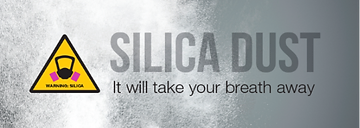What is Silica Dust and Where is it Found?
Crystalline silica is an important industrial material found abundantly in the earth’s crust. Quartz, the most common form of silica, is a component of sand, stone, rock, concrete, brick, block, and mortar. Materials containing quartz are found in a wide variety of workplaces. Common industries and operation where crystalline silica is found include: construction, glass products, concrete products, foundries, cut stone products, railroad track maintenance, abrasive blasting, and many more. Occupational exposure to respirable crystalline silica occurs when cutting, sawing, drilling, and crushing of concrete, brick, ceramic tiles, rock, and stone products.
Health Effects and Illnesses Caused by Silica Dust
Silica dust is hazardous when very small respirable particles are inhaled. These respirable dust particles can penetrate deep into the lungs and cause disabling and sometimes fatal lung diseases, including silicosis and lung cancer, as well as kidney disease. Crystalline silica is 1 of 119 agents listed as “carcinogenic to humans” by the International Agency of Research on Cancer also known as IARC.
Best Practices in Reducing Exposure to Silica Dust
Eliminate the source of the dust whether that is through engineering controls or a change in work processes. Use collection or vacuum systems to collect dust at the point of operation to avoid suspended the dust in the air. Use wet methods when cutting or breaking any concrete or similar materials. Use water as a means of suppression for the dust on roadways or in work areas. Stay out of areas where silica dust levels are high as well as avoiding being downwind from these areas. Use proper respirators when engineering controls are not enough to protect you
The Four Routes of Entry of Hazardous Chemicals
- Inhalation– Inhalation is the most common route of entry a person comes into contact with a chemical. Once inhaled, chemicals are either exhaled or deposited in the respiratory tract. Upon contact with tissue in the upper respiratory tract or lungs, chemicals may cause health effects ranging from simple irritation to severe tissue destruction. The chemical can also go onto affecting organs that are sensitive to the chemical.
- Absorption– Getting chemicals onto the skin or eyes can result in redness and irritation all the way to severe destruction of tissue or blindness. The eyes are especially sensitive to chemicals. Some chemicals have the ability to pass through the skin and get into the blood stream of a victim. This can lead to systemic problems in the organs.
- Ingestion– Chemicals that inadvertently get into the mouth and are swallowed do not generally harm the gastrointestinal tract itself unless they are irritating or corrosive. Some chemicals can be absorbed through the gastrointestinal track where they enter the bloodstream. Once in the bloodstream they can cause damage to the organs.
- Injection– Though not common, injection of chemicals into the body can occur. A sharp object can be contaminated with a chemical or substance and penetrate the skin. The chemical is then in the body and can make its way into the bloodstream where it can damage organs or other tissue.






